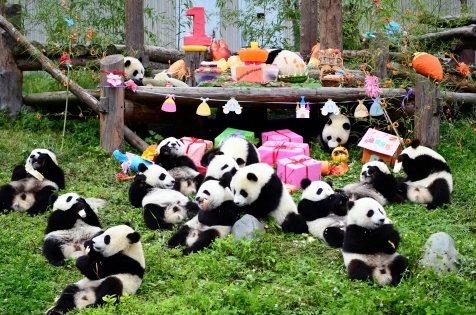Few animals capture hearts across the world like the giant panda. With its round face, black-and-white fur, and gentle personality, the panda is more than just a cute animal — it is a symbol of conservation success and a proud emblem of China.
Once on the brink of extinction, the giant panda’s journey from endangered species to global ambassador of wildlife protection is an inspiring story of hope, science, and dedication.
The Panda’s Home: China’s Misty Mountains
The giant panda lives only in China, mainly in the mountain ranges of Sichuan, Shaanxi, and Gansu. These mist-covered bamboo forests, sitting between 1,200 and 3,000 meters above sea level, provide the perfect environment — cool, damp, and full of bamboo, their primary food source.
Though pandas are classified as carnivores, about 99% of their diet is bamboo. A panda spends 10–16 hours a day eating, consuming up to 40 kilograms of bamboo daily just to get enough energy. This dependence makes them vulnerable to any loss of bamboo forest.

From Endangered to Protected
For decades, the giant panda was one of the world’s most endangered animals. By the late 1970s, fewer than 1,000 pandas were believed to survive in the wild, mainly due to deforestation, habitat fragmentation, and poaching.
In response, the Chinese government launched a nationwide protection program:
-
Panda Reserves: Over 60 nature reserves were created to protect bamboo forests.
-
Reforestation Projects: Deforested areas were replanted to reconnect panda habitats.
-
Anti-poaching Laws: Strong penalties were enforced to protect wildlife.
Thanks to these efforts — and the tireless work of scientists and conservationists — the giant panda population grew steadily.
In 2016, the IUCN (International Union for Conservation of Nature) officially changed the panda’s status from “Endangered” to “Vulnerable.”
This marked a milestone: the panda had stepped back from the edge of extinction.
The Role of Chengdu Research Base
One of the most important centers for panda conservation is the Chengdu Research Base of Giant Panda Breeding in Sichuan Province.
Here, scientists study panda behavior, genetics, and reproduction. Pandas are famously difficult to breed — females are fertile for only 2–3 days a year — but through advanced techniques like artificial insemination and careful pairing, the center has successfully bred dozens of cubs.
Visitors to the Chengdu Panda Base can:
-
See pandas of all ages, from playful cubs to mature adults.
-
Learn about panda ecology and conservation programs.
-
Watch how cubs are cared for by keepers and veterinarians.
✨ Tip: The best time to visit is early morning, when pandas are most active and feeding.
The Panda as a Global Ambassador
Beyond China, the panda has become a symbol of peace and friendship.
Since the 1950s, China has engaged in “panda diplomacy” — gifting or loaning pandas to other countries as gestures of goodwill. Today, pandas live in zoos across the world, including the U.S., Japan, France, and the U.K., all part of international breeding and research partnerships.

Went to Chiang Mai Zoo in Thailand in 2003 (has returned to China)
Pandas also serve as the logo of the World Wildlife Fund (WWF), symbolizing endangered species and global conservation efforts. Their image inspires millions to care about wildlife protection.
Challenges Ahead
Although the panda’s recovery is a success story, the species still faces challenges.
-
Habitat fragmentation continues as roads and farms divide bamboo forests.
-
Climate change may affect bamboo growth, reducing food sources.
-
Pandas raised in captivity need careful training before being reintroduced to the wild.
China’s conservation strategy now focuses on creating large interconnected reserves, allowing pandas to migrate naturally and find mates — crucial for long-term survival.
More Than a Symbol
The panda’s story is not only about saving one species — it’s about the power of conservation. By protecting pandas, China has also preserved the entire bamboo forest ecosystem, which shelters red pandas, golden monkeys, takins, and hundreds of bird species.
In a broader sense, the panda reminds us that humans can coexist with nature when we respect and protect it. Every forest restored and every panda born is proof that conservation works.

Giant Pandas
Conclusion
From near extinction to a thriving population, the giant panda’s journey shows what’s possible when a nation commits to protecting its wildlife.
Today, the panda stands as a symbol of hope, harmony, and environmental awareness, reminding us all that even the most fragile creatures can survive — if we care enough to act.
Whether you see them in the bamboo forests of Sichuan or at the Chengdu Panda Base, the story of the panda is a living example of China’s love for nature and life.











